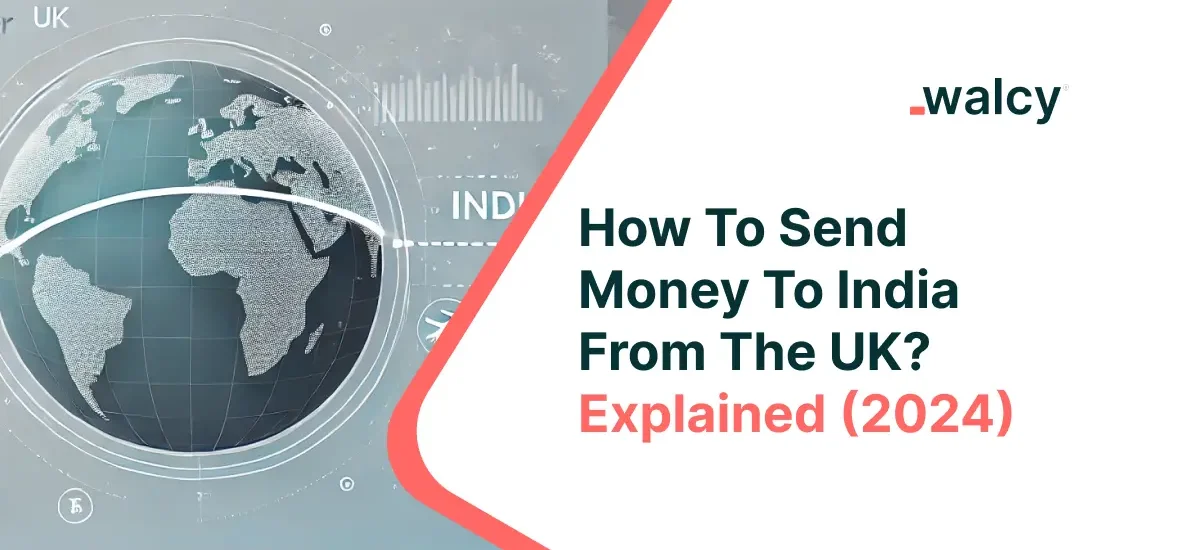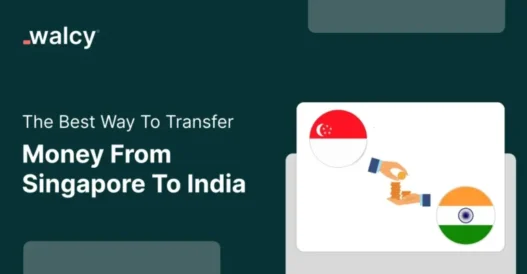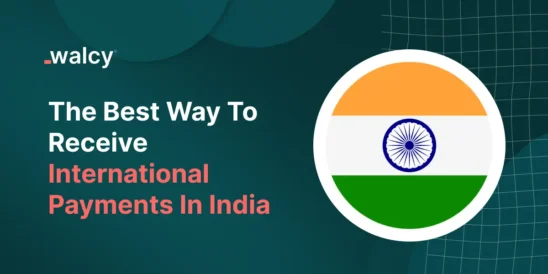The methods to send money at your fingertips globally have been further made easier and opened up by the availability of different choices for transferring money internationally. In case you want to send money to India from the UK or in a reciprocal way, knowing the methods, fees, and top practices to choose the best option for the transaction might be the trigger for your decision.
Here is a comprehensive guide on how to send money to India from the UK and vice versa.
Understanding How International Money Transfers Work
International money transfer simply implies sending money from one country to another using banks, money transfer services, or even online platforms. The processes involved in the transaction usually begin when the sender initiates a transfer; then, the money is exchanged into that to be received by the recipient before finally being delivered to them either in their accounts or at a local agent.
Methods Of Sending Money To India From The UK
- Bank Transfer
This is one of the oldest methods of money transfer from the UK to India. Most banks in the United Kingdom offer services for international money transfers to India.
-
- Pros:
- More secure and reliable;
- It is a familiar process if one has an existing bank account.
- Cons:
- higher fees compared to other methods;
- longer processing time as it takes about 3-5 business days;
- Less favorable exchange rates.
- Pros:
- Money Transfer Services
International money transfer services such as Western Union, MoneyGram, and others are another viable way to transfer funds internationally.
-
- Pros:
- Sync across all devices with the ability to fee capture, which allows for machine learning on customer trends
- Fast transfer time—mere minutes to a few hours
- Cons:
- Higher fees compared to online services
- Pros:
- Online Transfer Services
Online transfer services, such as Walcy, Transfer Wise, and World Remit, have been gaining much attention lately due to their ease of use and competitive rates.
-
- Pros:
- Less costly
- Better exchange rates
- Fast transfer time
- User-friendly applications and websites
- Cons:
- Broadband access is required, technical knowledge to some extent is needed
- Pros:
- Mobile Wallets and Apps
Mobile wallets and apps, the likes of PayPal, Paytm, and Google Pay, make it easy to send money to India.
-
- Pros:
- Instant transfer
- Easy to use
- Cons:
- Sender and Receiver require the application
- May have lower transfer limits
- Pros:
Best Ways to Send Money To India from the UK
We knew the methods of sending money to India from the UK above. What would work best in sending money to India from the UK depends on variables of cost, speed, and ease of convenience. Some of the best options are given below.
-
Walcybank:
Most easiest, most affordable, and most convenient way to send money to India from UK is the use of Walcybank. Walcybank is a Neobank, which allows sending and receiving international payments globally. It also allows you to open a global account by which you could manage different currencies in a single platform. Moreover, you can expect unbeatable FX rates with Walcybank.
-
Wise (formerly TransferWise)
Known for passing on real exchange rates—the same rate you see on Google—while charging low and transparent fees.
- Pros:
- Real exchange rate
- Low, transparent fees
- Fast transfers
- Cons
- Requires online access
- Pros:
-
Remitly
Remitly has two options available to clients: Economy and Express. The economy option is cheaper but slower, while the express option is faster but costlier during sending money from India to the UK.
- Pros:
- The flexible option of Economy and Express
- Competitive rates
- Fast transfer times with Express
- Cons:
- Higher fees for Express transfers
- Pros:
-
World Remit
World Remit has additional payout alternatives available to clients, including bank transfer, cash pickup, mobile money, and airtime top-up.
- Pros:
- Payout options are numerous
- Competitive rates
- Fast
- Cons:
- The fees may be a little higher for some of the payout choices available
- Pros:
-
Xoom
Xoom—a PayPal service—also offers both speed and security to India with different payout alternatives. Pros include speed, pay-out options, and integration with PayPal. The main con relates to higher fees for mid-range transfer amounts. Sending money from India to the UK is the same process with a few specific considerations.
- Pros:
- analytical and critical thinking
- You may already be familiar with the process if you have a bank account
- Cons:
- Slightly more expensive than other methods
- A little slower processing times
- Pros:
-
Money Transfer Services
There are various services for sending money from India to the UK , such as Western Union and MoneyGram.
- Pros:
- Wide availability with numerous agent locations
- trail transfer times
- Cons:
- Slightly higher fees
- Poorer exchange rates
- Pros:
-
Online Money Transfer Services
Online services like Wise, Walcybank, and Revolut charge competitive exchange rates and are hassle-free.
- Pros:
- Lower costs on fees
- Better exchange rates
- Faster transfer times
- Cons:
- You must have access to the internet and some level of technical knowledge.
- Pros:
-
Mobile Wallets and Apps
Mobile wallets, for instance, PayPal, and Google Pay, among others, also gain huge grounds as a way of international transfer from India to the UK.
- Pros:
- Instant transfer
- Easy and convenient to use
- Cons:
- Both sender and recipient should have the app.
- May have lower transaction limits.
- Pros:
Best Ways To Send Money From India To The UK
Walcy:
The first in the list comes the Walcy, as it is being increasingly popular in short period of time. The major benefit of using Walcy is its cheaper fees as compared to other banks and financial service providers. Additionally, users can also benefit from the cheaper FX rates following the midmarket rate. Unlike other alternatives, you shouldn’t worry about any hidden fees. Every transaction in this platform is
InstaReM
InstaReM offers competitive rates and fast transfers, making this service a good way to send money to India from the UK.
- Pros: Competitive rates and fast transfer speeds
- Cons: Online access required
Know more about Foreign Exchange Rates
Remit2India
Excellent in transfers from India to any country around the globe, Remit2India retains very competitive exchange rates, especially with several options for payout. Pros include competitive rates and several payout options. Cons include higher fees for some options.
Xoom:
Quick and safe transfers available with Xoom from India to the UK, with several payout options. Pros are fast transfers, multiple payout options, and integration with PayPal. Cons are higher fees for certain amounts that are being transferred.
Charges For Sending Money To The UK From India
While you choose between the methods of sending money abroad, you must also compare their charges and charges. Bank Transfers may turn out to be costlier due to less competitive exchange rates and high transfer fees. While sending money to India from the UK , you will be charged £10-£30 for transfers, and while sending money from India to the UK, it ranges from ₹500-₹2000.
- Money Transfer Services
The fees of Western Union and MoneyGram vary accordingly, depending on the amount one is transferring and the speed at which it is delivered. For example, if a person from the UK is to send funds to India, it can range from £5-£20, and vice-versa, for ₹300-₹1500.
- Online Transfer Services
Online transfer services, such as Wise, Remitly, and World Remit—generally charge lower fees with relatively better exchange rates. The fees can be in the range of £2-£10 while sending money from the UK to India and ₹150-₹500 while sending money from India to the UK.
- Mobile Wallets and Apps
First off, mobile wallets and apps, like PayPal and Google Pay—generally charge less for small amounts, but might be more expensive for larger transactions. These would typically cost from £0 to £5 when sending money from the UK to India and from ₹0 to ₹200 when sending money from India to the UK. Factors that will help you choose which transfer method to take include:
-
- Exchange Rates:
The exchange rate can also sweep a significant portion of money from the amount received by the receiver. Ensure that the service used provides the mid-market exchange rate or one that is very close.
-
- Fees levied for transferring money or receiving it in the destination account.
Some service providers charge a transfer fee along with a receiving fee or an intermediary bank fee. You must be smart and careful in this regard.
-
- Transfer speed
In some cases, speed may be a major factor. If the need to send money is immediate, then seek a provider who transfers money quickly, regardless of higher fees.
-
- Ease of use.
Use the one that is most convenient to both you, the sender, and the recipient. Needless to say, online services and mobile apps move out of the way to provide maximum ease of use.
- Security
The service chosen should be reputable and secure to ensure money and information are safe.
Know about the fees associated with the international transfers
Conclusion
The options available make it easier than ever to send money between the UK and India. Be it traditional bank transfers, money transfer services, or online, or mobile application-based solutions—there is one for everyone. Keeping some essential criteria in mind, such as the best exchange rate, fees, speed of transfer, and convenience, choose the best way to send money to India from the UK or vice-versa.
Always check the comparison amongst different options, and familiarize yourself with the latest services and offers that will help you attain the cheapest and most effective option for money transfers to another country.
Know the cheapest way to transfer money abroad.
Do follow us on Facebook and Linkedin, to stay connected with us.



